
18. GTM - Stage 01 : Allos - Estenc
10 points of interest
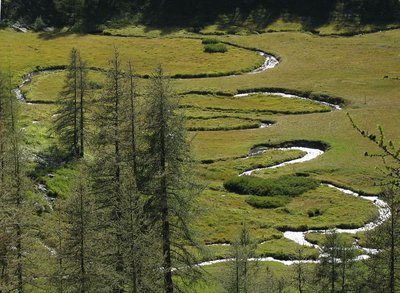
La Serpentine est le nom donné au torrent du Chadoulin, (affluent du Verdon), sur le haut de son cours, sur le plateau du Laus - Le Bouteiller Éric  Flora
FloraSecrets of the peat bog
This vast grassy expanse is one of the finest peat bogs in the Mercantour.
Peat bogs are rich in information: its depth is more than 8 metres. The succession of layers contains precious clues (grains of pollen, plant debris, etc…). They allow scientists to date things back as far as 9500 years ago.
These wetland areas which have little oxygen but plenty of nitrogen are home to flora adapted to the environment, namely bog plants: sphagnum moss, cotton grass with its gracious white cotton toupee as well as Alpine butterwort, one of the carnivorous plant species which can be found in France.
La Serpentine est le nom donné au torrent du Chadoulin, (affluent du Verdon), sur le haut de son cours, sur le plateau du Laus. - CULOTTA Jean-marc  Geology
GeologyThe grassy plateau of Laus
The grassy plateau of Laus has been a living memory of life for 9000 years. It was created as the glaciers shrank, a lake occupied the site. The fact that it was not very deep, in addition to the floods of sediment and organic matter flowing into it accelerated the process of filling in this lake. The biggest role was played by bryophytes: while their roots decompose, bryophytes keep growing upwards, trapping pollen. Analysing them allows us to retrace the history of existence in the area.
Despite gradually drying out for several thousand years, the process is still ongoing today. This environment is still damp and contains plants which are more readily associated with peat bogs. The winding curves of the Serpentine gleam on this plateau.
La Serpentine est le nom donné au torrent du Chadoulin, (affluent du Verdon), sur le haut de son cours. - LE BOUTEILLER Eric  Geology
GeologyWhere is this water coming from?
The beautiful outlet that you see before you is a singular case in hydrogeology: it is unique in the Mercantour and almost so in the Alps! Indeed, this water is escaping from Lac d’Allos which makes it a very rare case of a lake without an overflow and it is even more remarkable when you consider that this is the biggest natural high-altitude lake in Europe whose depth varies from 42 to 49 metres depending on the year.
The spring formed is called Chadoulin, an affluent of the left bank of the Verdon.
Le lac d'Allos - GOURON Claude  Lake
LakeLac d'Allos
Created by the glaciers of the quaternary period, Lac d'Allos is the biggest natural lake at this altitude in Europe (62ha). It waters come from the thawing snow as well as from springs, and they reach up to 42m in depth. It burgeons with more life than in the previous lakes: invertebrates, juvenile fish, brown trout and arctic char.
Lac d'Allos is an incredibly fragile environment due to the extreme conditions and the low number of plant and animal species. The arctic trout which exist here are, for reasons which remain unknown, affected by dwarfism. Any pollution or modification of the environment would be disastrous. But the presence of the National Park should today ensure that the lake can live in peace.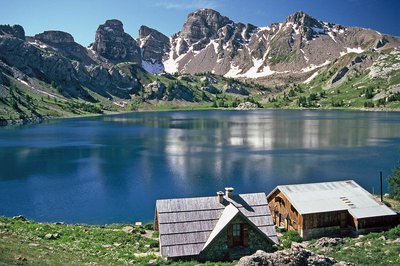
Le lac d'Allos, (2228 m), le refuge des bords du lac, en fond, les Tours du Lac, en début d'été - LAURENT Olivier  Refuge
RefugeLac d'Allos refuge
Refuge managed by the commune of Allos
Refuge-bar-restaurant
Capacity: 40 places
Warden: June to September. Shelter room located just above the refuge, open 365 days per year.
Tel. 04 92 83 00 24
http://refuge-du-lac-dallos.com
Val d’Allos Tourism Office: 04 92 83 02 81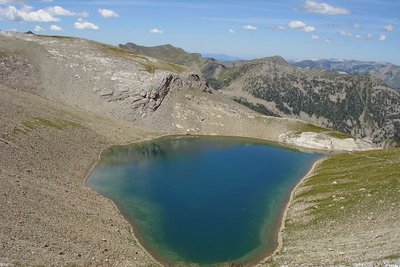
Le lac de la Petite Cayolle en été, dans sa combe minérale, vue plongeante vers le haut-Verdon. - COSSA Jean-Louis  Lake
LakeLac de la Petite Cayolle
It is a story of long ago, of the great glaciers which, as they slowly but unstoppably moved, shaped the Alps. Their flow hollowed out softer rocks and smoothened the harder ones, ripping any obstacles out of their way.
10000 years ago, the time of the great blanket of ice and snow came to an end and the glacier began shrinking, leaving behind it great hollows and terminal moraines: the glacial lakes found a home there, like Lac de la Petite Cayolle 3000 years ago.
Le lac des Garrets, (2621 m), le Lausson, randonneur. Paysage très minéral. - DEMONTOUX Daniel  Lake
LakeLac des Garrets
The lake incurs the ramifications of its high altitude. The high level of evaporation in the summer sees it shrink, giving it the characteristic shape of a wine glass in autumn. The freezing weather which causes it to “hibernate” for nearly 8 months a year, would appear to prevent life from surviving in it. However, an energy-capturing phytoplankton began developing there, opening the way to life in the mountain lakes.
Here, however, life halted at the plankton stage. The rare organic matter is used by an inactive lifeform. Given that the lake is “cleaned” in this fashion , the waters of this oligotrophic lake are clear, despite it being stagnant.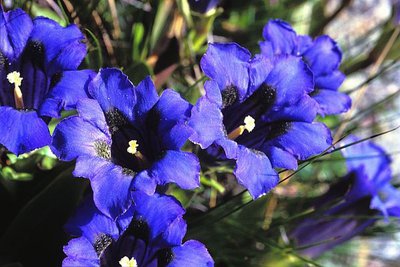
Gentiane de Koch en gros plan, (Gentiana kochiana). - LOMBART Guy  Flora
FloraFrom one cairn to another
A bare, secretive and fascinating environment: From Pas du Lausson to Col de la Petite Cayolle, these are the high mountains. The décor is rocky and grass is thin on the ground. This is also the stronghold of audacious plants. In order to protect themselves against the hostility of the climate, they are small and perennial, often with large and colourful flowers.
This vegetation which, highly adapted to climatic hardships, is fragile and of exceptional value. Plants which can be found here include the spring gentian, moss campion, glacier crowfoot, the stemless gentian, Alpine toadflax…, but also certain endemic species like Berardia subacaulis and Campanula allionii.
Refuge de la Cantonnière - Refuge de la Cantonnière  Refuge
RefugeLa Cantonnière refuge
The history of the refuge is closely linked with the Route des Grandes Alpes connecting Lac Léman with the Mediterranean. It was built in the early 20th century by the French Touring Club with the very rudimentary means of the period by Italian workers, for whom the imposing Cantionnière house was built.
Accessible in summer 1913 to the few automobiles which were around at the time, the road was to be inaugurated by President Poincaré in August 1914. But the declaration of war deprived the people of Entraunes of this visit.
The building today serves as a refuge and has been fully renovated by Mercantour National Park.
Capacity: 36 in dormitories of 2, 4, 5 and 18.
Prices and opening periods: http://lacantonniere.wixsite.com/refugelacantonniere
Tel: 04.93.05.51.36
E-Mail: lacantonniere@gmail.com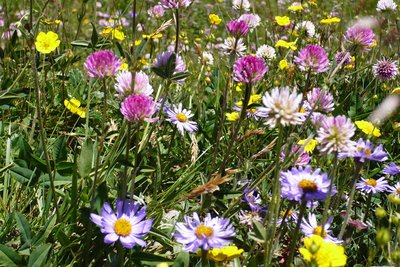
Portion de prairie fleurie - Marc EVENOT  Pastoralism
PastoralismEstenc plateau hay meadows
The term “hay meadows” means areas of production of fodder which was not deliberately planted and which are rich in variety of species. The hay is harvested to feed animals. These meadows are part of the non-intensive and environmentally friendly practices and they encourage a wide variety of plants to grow.
Mercantour National Park has 1000ha of hay meadows, included in a pastoral and grassland domain covering around 120000ha. Within this, 90 professional farms are based in the Park’s communes and 268 transhumant farmers are present in summer.
Description
The path sets out from the carpark and goes past the Laus forest house via the interpretation path which leads to the lake. Follow the marked path, which has been made into a guided circuit with explanations about the landscapes and the flora, leading to the refuge. This will take 2à minutes. Subsequently, the setting is astonishing with the biggest glacial lake in Europe, locate at 2230m altitude.
From the refuge on the shores of the lake, join the marked GR path via the flat footpath which crosses the beautiful prairie until you reach an altitude of 2259m. At the intersection, take the path which heads to the right and rises towards Petite Cayolle (lake and col) which you can see ahead of you.
To the left is the summit of Les Garrets (2822m). In the distance on the right, La Tête de Valplane (2624m), then La Tête de Monier (2544m).
At around 2250m, you will reach a plateau and then there is an intersection, although the two paths meet up again further up. You can either take the GR de Pays du Haut Verdon towards the right or take the path which heads off to the left, also leading to Mont Pelat (3051m). After several bends, you will arrive at Lac de la Petite Cayolle (2588m); continue to the col which carries the same name and is located a bit higher up (2639m).
Take the path along the rock face towards Lac des Garrets. The path goes along in a rocky environment, passing below the Sommet des Garrets (2822m). You will then arrive at Lac des Garrets (2621m). Follow the wide ridge to reach the Pas du Lausson with its splendid panoramic view. At Pas du Lausson (2602m) on a path along the ridge, Lac d’Allos is on one side and the high Var Valley and the hamlet of Estenc on the other.
Having admired Lac d'Allos one last time on the edge of the plateau, begin the descent towards Estenc. You will successively cross three valleys on a contoured path and then take a right fork towards (marker 294). On a hairpin bend, there is a spectacular view over the rolling Col de la Cayolle road away to your left. Reach the larch forest and continue along the path which now heads downhill towards the bottom of the valley. Go past the Les Garrets forest house and turn right at marker 293. After having joined La route de la Cayolle, you will then only need to follow the road for 200m downhill and to the right to reach your accommodation for the night.
- Departure : Lac d'Allos
- Arrival : Estenc
- Towns crossed : Allos, Uvernet-Fours, and Entraunes
Altimetric profile
Recommandations
Report a problem or an error
If you have found an error on this page or if you have noticed any problems during your hike, please report them to us here:



